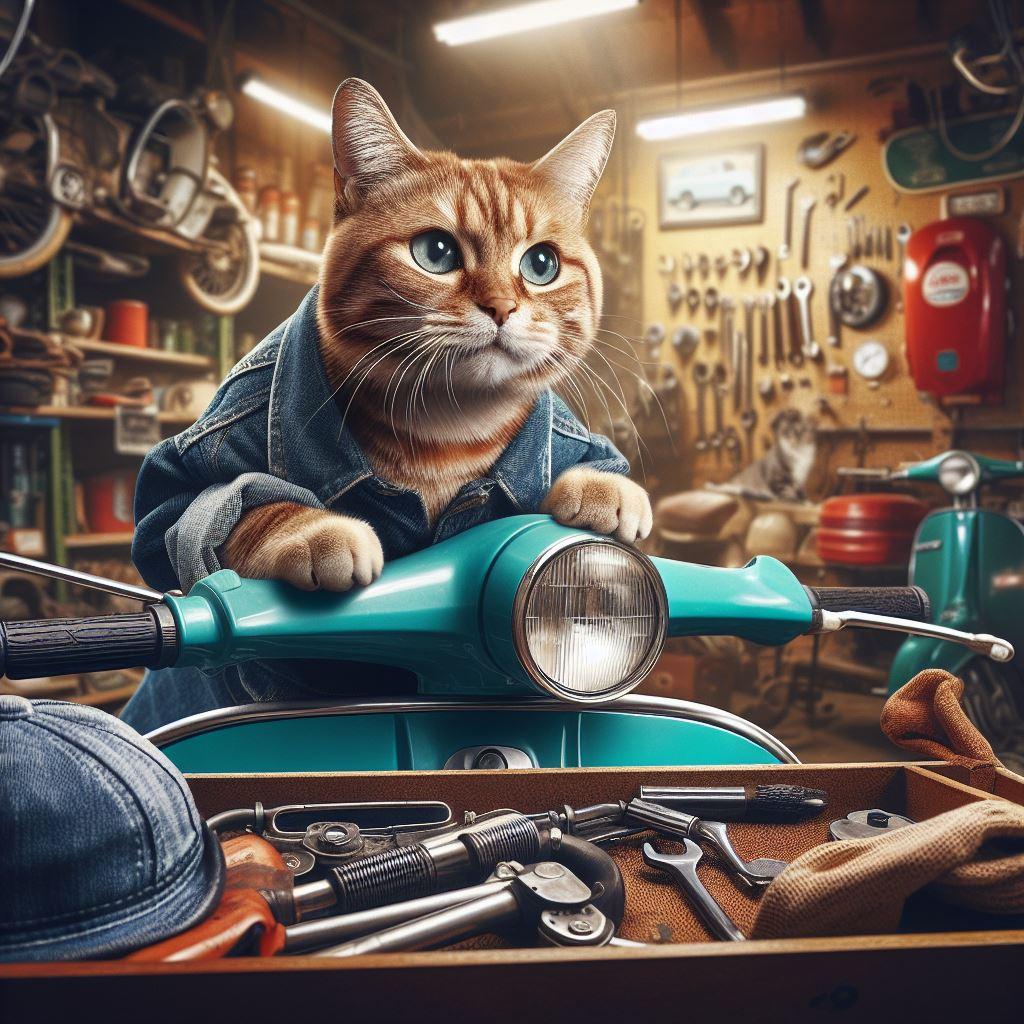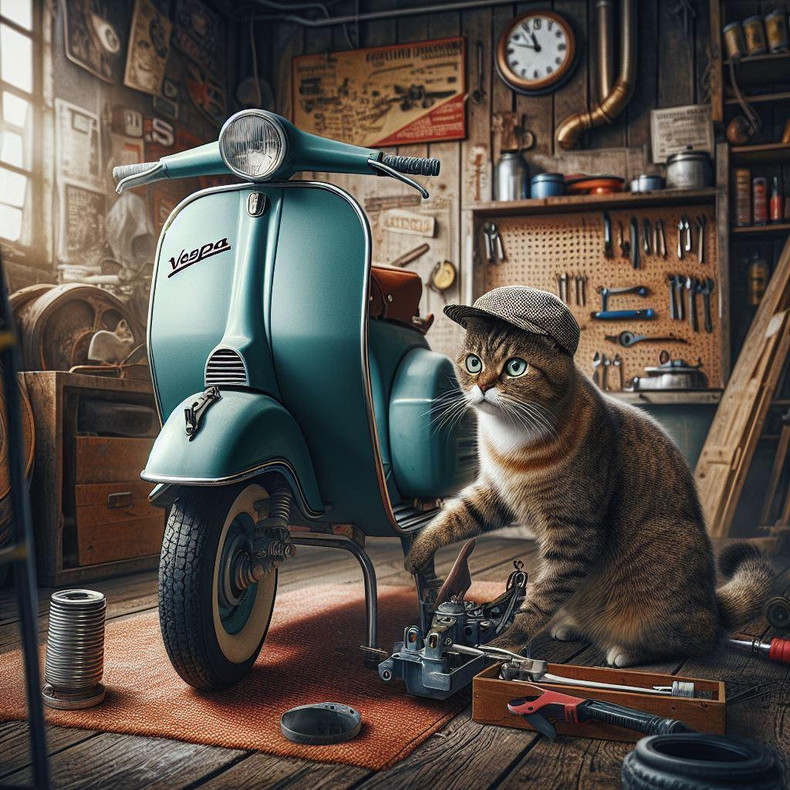Here in Minnesota, scooters spend 6 months out of the year sitting so it is common after winter to find your scooter won't start. We will walk you through diagnosing why it won't start, tell you what you can do to get it running again and also help you prevent this from happening in the future.

The first thing you need to do: determine whether your scooter is fuel injected or carbureted.
Fuel injected and carbureted scooters share a lot of similarities, but the process of getting them running after winter is dramatically different. Use the following lists to determine whether your scooter is fuel-injected or carbureted:
Here is a list of the more popular fuel injected models sold in the United States:
| Vespa:
GTS250 2006-2010 GTV250 GTS300 2010-current GTV300 LX150ie 2009-2013 LXV150ie S150ie 2009-2013 Primavera 150 2014-current Sprint 150 2014-current Primavera 50 2019-current Sprint 50 2019-current |
Piaggio:
BV250ie 2008-2011 BV350 2012-2021 BV400 2022-Current Liberty 150 2018-current Fly 150 2013-2019 MP3: Various years and displacements |
| Genuine Scooter Company
Blur 220 Buddy 170 Buddy Kick Hooligan 170 Urbano 50 Urbano 200 Brio 50 Rattler 200 |
Kymco
Xtown Yager AK550 Myroad 700 Xciting (with ie designation) Compagno 110 Like 50i Like 150 Like 200 |
| SYM
Fiddle III 200 Fiddle IV 200 Citycom 300 Jet14 200 |
Lance
Cali Classic 200 Havana Classic 200 PCH 200 Cabo 200 |
| Honda
Metropolitan 2013-Present PCX150 SH150 Elite 110 Silverwing 600 ADV160 |
Yamaha
Zuma 50 2012-current Zuma 125 2008-current Smax 150 Majesty Morphus Xmax |
If you own one of the fuel injected models listed, then jump ahead to learn why your scooter will not start.
Here is a list of the more popular carbureted models sold in the United States:
| Vespa:
ET2 ET4 LX50 S50 LX150 2006-2009 S150 2006-2009 GT200 |
Piaggio
Fly 150 2006-2012 Fly 50 BV200 BV250 -2008 MP3 250 BV500 |
| Genuine Scooter Company
Buddy 50 Buddy 125 Buddy 150 Blur 170 Stella 2t Stella 4T Stella Auto Venture 50 Rattler 125 Urbano 125 Roughhouse 50 Black Cat 50 |
Kymco
People 50/S50 People 150 People 200/S200 People 250 Xciting pre-ie Agility 50 Agility 125 Super 8 50 Super 8 150 Super 9 |
| SYM
Fiddle 50 Mio HD200 |
Lance
Cali Classic 50/125/150 Havana Classic 50/125/150 PCH 50/125/150 Soho 50 Cabo 50/125/150 Italia Classic 150 |
| Chicago Scooter Company
Go 50 Go Max 50 Bella 50 Pug 50 Nitro 50 |
Royal Alloy
GT150 |
| Honda
Metropolitan 2002-2009 Ruckus 50 Big Ruckus Elite 80 Helix 250 Reflex Aero Elite 50 Spree |
Yamaha
Vino 50 Vino 125 Zuma 50 2t Razz Riva |
*This is by no means a complete list, just a list of the most recent and most popular models*
If you have fuel injection:
- 1.Charge your battery: using a good quality battery charger that tells you whether the charger recognizes the battery or not and if it has reached full charge. Fuel injection requires a good battery in a good state of charge. If your battery charger does not tell you that it is charging the battery or that your battery is fully charged, consider getting one that does. Also note that just because a battery charges and is fully charged, does not mean your battery is any good.
Scooter batteries are very small and they lose a percentage of charge every month that they sit. If your battery was sitting in a cold garage for 5 months without being plugged into a battery maintainer, there is a pretty good chance it is toast as the charge depletes low enough that the acid in the battery becomes water and freezes, which destroys even the best batteries.
- 2.Start it up! Once you have verified that your battery is charged and in good working order, go ahead and start that scooter up!
- 3.Check your tire pressure: Always, always, ALWAYS check your tire pressure before riding after it has been sitting all winter. Set the tire pressure at the manufacturers recommended pressure and NOT what is printed on the sidewall of the tire.
- 4.Ride
If your scooter has been sitting for more than a year or does not start when following these instructions, you may have other issues. Common issues with fuel injected scooters that have been sitting for multiple years are: fuel pump failure, plugged fuel injectors or various other electrical issues. You may need to see your local dealer to diagnose and repair these issues.
If your scooter is carbureted:
- 1.Charge your battery: using a good quality battery charger that tells you whether the charger recognizes the battery or not and if it has reached full charge. If your battery charger does not tell you that it is charging the battery or that your battery is fully charged, consider getting one that does. Also note that just because a battery charges and is fully charged, does not mean your battery is any good.
Scooter batteries are very small and they lose a percentage of charge every month that they sit. If your battery was sitting in a cold garage for 5 months without being plugged into a battery maintainer, there is a pretty good chance it is toast as the charge depletes low enough that the acid in the battery becomes water and freezes, which destroys even the best batteries.
- 2.Kickstart it: One of the tricks we use to start a scooter that was not stored properly is we will kick start it. When kickstarting your scooter, it is important that the key be turned to the on position and that the kill switch is pointed towards the run position (usually a circle, not the circle with the “X” through it). You do not need to hold the brake lever or give it gas to kickstart it. We recommend kicking it 30-40 times consecutively until it starts running. One it starts running, let it run for a few minutes without giving it any throttle.
- 3.Choke it: A little known trick you can use to start a carbureted scooter that has been sitting is to “force choke” it. What you need to do is find the air intake portion of the air filter box and block it completely. On many scooters it is a small hole that you can fit your finger into. On others it is a snorkel that you can squeeze completely shut with your hand. Once you have found and plugged it, hold the electric start button down, turning the engine over until it starts. Once it starts, pull out your finger or release the snorkel as failure to do so causes the engine to flood out. Once it is running, let it run without touching the throttle for a few minutes.
- 4.Spray carb cleaner into the air box: Carburetor cleaner isbasically ether (starting fluid) so you can spray some into the air filter box intake hole while holding the throttle wide open. Once you have done that, continue holding the throttle wide open while holding the electric start button down. When it starts, let it idle for a few minutes without applying any throttle.
- 5.Check your tire pressure: Always, always, ALWAYS check your tire pressure before riding after it has been sitting all winter. Set the tire pressure at the manufacturers recommended pressure and NOT what is printed on the sidewall of the tire.
- 6.Ride
If the above methods did get your scooter to start, or it started but will not stay running, then you probably need your carburetor cleaned or replaced.
One of the more common calls we get is “my scooter started and ran but it died at the stop sign and now it won’t start.” What is happening in this scenario is the “auto-enrichener or auto-choke” is open when you first start it, which feeds extra fuel into the engine. As the scooter warms up, that circuit closes and when it is completely closed, the pilot circuit in your carburetor is running the engine at idle. If that circuit is plugged, the engine will not stay running once it warms up.
Why do carburetors need to be cleaned? Fuel evaporates over time and leaves behind a dirty residue. Think of it like a bottle of nail polish remover (acetone) that you leave the cap off and when you come back to use it, it is gone. Fuel behaves the same way but it is much dirtier. It spoils or “goes bad” after a while and evaporates. What is left is a film that plugs the tiny jets and orifices in your carburetor.
On Chinese scooters, we typically replace the carburetor since it is cheaper, faster, and easier to do. Plus, a lot of the Chinese carburetors come with anti-tamper screws in the float chamber that make it near impossible to clean without breaking something. On name brand scooters with more expensive carburetors, we take them apart and clean them piece by piece so that the inside of the carburetor looks clean enough to eat out of. We also blow through and inspect all the jets and orifices to make sure there is no blockage. Under extreme conditions on scooters that have been sitting for many, many years, we sometimes have no choice but to replace them as they are just too far gone.
How can I prevent this from happening?
- 1.Use ethanol-free gasoline if it is available in your area. Ethanol-free (non-oxygenated) gas breaks down much slower than gas with ethanol in it.
- 2.Drain your carburetor float bowl before you put your scooter into long term storage. The float bowl on a scooter holds about ¼ cup of gasoline and draining that out will prevent any issues in the spring
- 3.Clamp your fuel line if you can’t drain the float bowl or getting to it is too difficult, purchase a fuel line clamp. Clamp your fuel line before the carburetor and run the scooter until it dies. This is not quite as fool proof as draining the float bowl but we have found it to be extremely effective in preventing runnability issues in the spring.
- 4.Treat your gas with a fuel stabilizer. This WILL NOT prevent you from needing to clean your carburetor in the spring if you failed to do steps 2 or 3. It only makes your gas ok to run when spring rolls around.
If you need batteries, carburetors or carburetor parts, Piston Ported stocks what you need to get your scooter running again!

